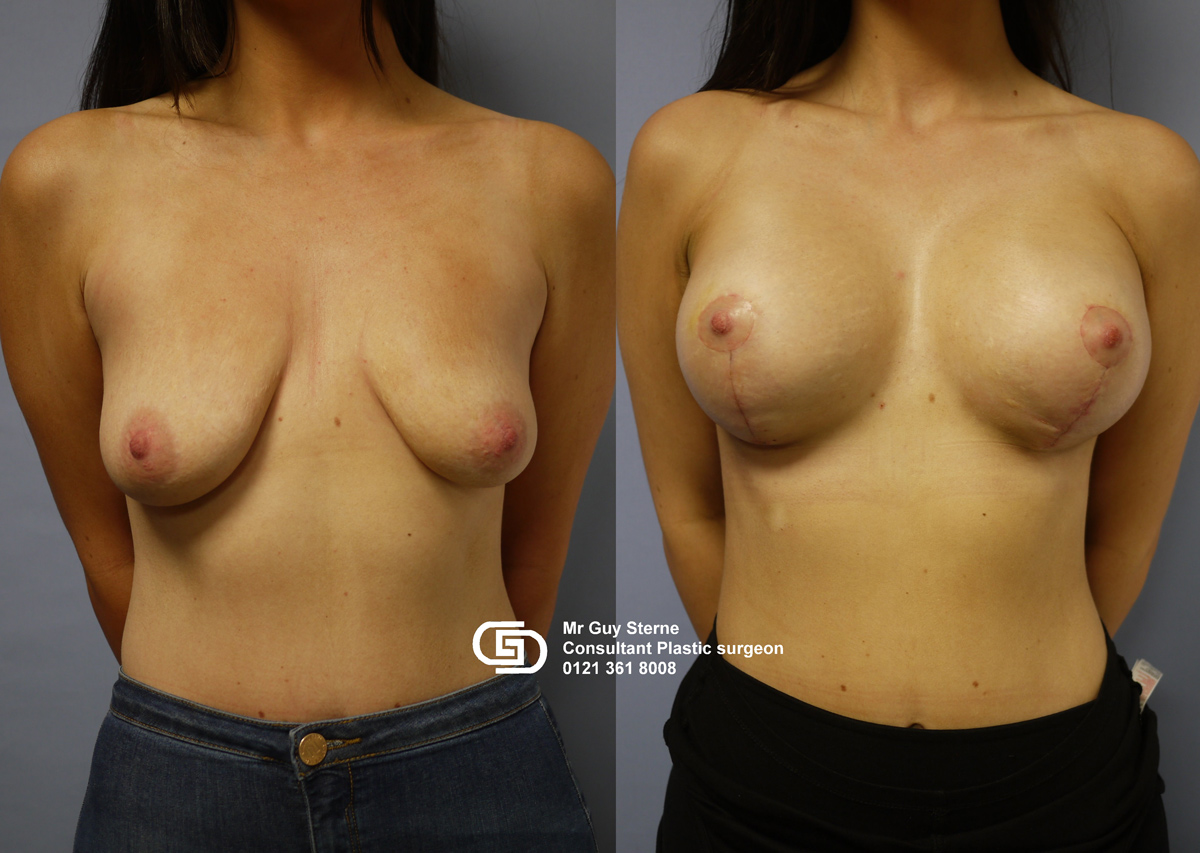Tuberous, Poland Syndrome and Tubular breast surgery
Breast asymmetry correction
Abnormal-shaped breast surgery
There are several reasons why women have abnormally shaped breasts and these only become apparent once the breast starts to grow – at about the age of 10-12.
Breast development usually takes about two years from start to finish. After this, if the breast is abnormally shaped, it will not improve with age.
The only time women may experience additional breast growth is with hormonal changes (eg starting the oral contraceptive pill, pregnancy, or the menopause) or through weight gain.
Choosing the right surgeon
Treatment of abnormal shaped or uneven breasts is complex and difficult, so it’s essential to choose a surgeon with the right experience and expertise to get the best possible results. I have been carrying out cosmetic and reconstructive breast surgery for over 20 years, so I know how different procedures can help achieve the look you are hoping for and I will be honest about the outcomes you can expect.
There is not one single solution to the problems of abnormal-shaped breasts.
You need to consider whether you would be willing to go through multiple operations, what degree of improvement you would happily accept, how much money you want to invest, how much downtime your life allows etc.
During your consultation, we will discuss all the issues, different treatments and the realistic outcomes you can expect from each – bearing in mind your own situation.
We will not go ahead with any procedure unless you are totally happy with the treatment I recommend.
Types of abnormal breasts
The common types of abnormally shaped breasts are:
Tuberous breast surgery
An unusually tight, deep, layer of tissue which restricts breast growth (especially in the lower half of the breast) is thought to cause tuberous breasts. This layer is not present at the areola and so the growing breast tissue pushes through the weaker tissue of the areola. Many girls notice that when they are cold and the areola ‘tightens’ they get a better breast shape.
Treatment of tuberous breasts is difficult and – like all surgery – must be tailored to suit each individual patient.
Treatment is designed to increase the breast volume, widen the breast ‘footprint’ and tighten the areola, but results are unlikely to be as good as through enlargement of normal breasts. The tightness in the crease under a tuberous breast is notoriously difficult to get rid of and can sometimes result in a ‘double bubble’ deformity.
Tubular breast surgery
Very similar to a tuberous breast, tubular breasts tend to have more growth and as the breasts enlarge, they form a long tube-like shape. Because the tissue is in the wrong place, it needs to be reshaped using mastopexy or breast reduction techniques. The results are not as good as with cosmetic mastopexies or reductions
Poland Syndrome surgery
This condition can affect the shape of the breast as well as causing abnormalities in the shape of the chest wall and arm/hand on the affected side. Typically, girls with Poland Syndrome will have one small breast (or even no breast) and no pectoralis muscle on the affected side.
I can offer a number of treatments, including grafting fat from other parts of the body, using an implant, or something called ‘flap reconstruction’ to improve the balance between the two breasts. Whilst surgery can vastly improve breast shape, it’s difficult and the results are not as good as breast enlargement of normal breasts.
It’s also possible to transfer muscle to disguise the absence of muscle at the front of the armpit. If you have Poland Syndrome, we will discuss all your options in great detail before deciding on the right course of treatment for you. I will be very honest with you about what can realistically be achieved so you understand exactly what to expect.
Breast asymmetry surgery
A woman’s natural breasts are rarely exactly the same. Whilst most women aren’t bothered by small differences in size/shape, an obvious difference can cause distress and embarrassment.
Breast asymmetry is usually apparent early on in puberty.
If there is a small size difference, the smaller breast may ‘catch up’ to match the larger one, so it’s wise to wait and see what happens.
The breasts are usually fully developed by about the age of 18, but if a very large difference exists early on, it’s unlikely the smaller breast will catch up, so you should seek a referral from your GP.
What can be done about different sized breasts?
There are several options to help make both breasts a better match. In each case, the aim is to get an acceptably close match for shape and volume.
Enlarge the smaller breast
A silicone implant or fat (taken from elsewhere on your body) can be used to enlarge the smaller breast so it closely matches the larger breast (see breast enlargement and fat transfer).
Enlarge both breasts
If both breasts are quite small, a silicone implant or fat can be put into both breasts, using a larger implant (or more fat) in the smaller breast to even out the size.
Reduce the larger breast
The larger breast can be made smaller by a breast reduction operation or by liposuction. Liposuction offers the advantage of less scarring, but the reduction is limited and there is less control of the final breast shape.
Read about liposuction and find out more about breast reduction surgery.
Reduce both breasts
If both breasts are rather large, they can both be reduced. The larger breast can be reduced more than the smaller breast to result in equal sized breasts.
Non-surgical treatment – If you don’t want surgery, a small silicone prosthesis can be made for you to slip inside your bra to pad out the smaller breast and achieve a more balanced look.
Mr Guy D. Sterne
MB, ChB, FRCS, MD, FRCS (Plast)
Consultant Plastic Surgeon











































